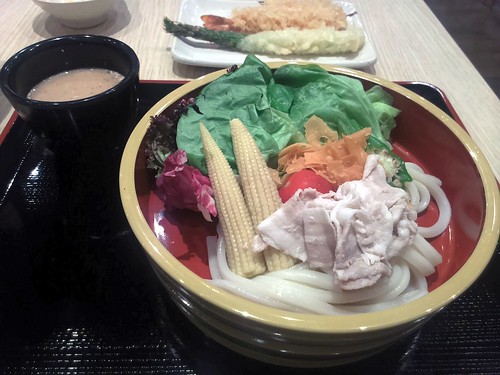Mweka Camp (3,100m) to Mweka Gate (1,500m)
Day Six is the last day on Kilimanjaro, and is generally the easiest of all. The trail leads out of Mweka Camp and descends fairly rapidly through the Cloud Forest on the slower slopes of Kili. It's basically a simple hike out of camp and off the mountain, but since this route is used by everyone on their descent, no matter which route the took to the top, it can be busy and crowded at times.
In total, it will only take about three to four hours to hike down to Mweka Gate. The first half of that time will be on well groomed, but narrower trails that have a few steep points that you'll have to navigate with caution. It can be quite wet in the Cloud Forest, especially in the rainy season when I was there, so the rocks and trail can be slick in points. The further you descend though, the more the trail levels out and eventually you'll find yourself hiking on what can best be described as a road. It's wide, easy to navigate, and you'll make good time. Before you know it, you'll reack Mweka Gate, and your Kilimanjaro adventure will be over.
From Mweka Gate you'll sign the guest book one more time, then take a break while the guides and porters organzie the vehicles for your return to Moshi or Arusha. There will be a number of locals trying to sell you everything from T-shirts and soft drinks, to cheap jewelry and "tinga tinga", which is local art work. At this point, the climb is over, and the one thing on your mind is a hot shower.
For me personally, the last day was a fairly easy hike out. Your legs are tired from several days on the mountain, so in the steep portions of the descent you'll feel some exertion, but other than that, this is just a few hours walk down and off the mountain. After the days spent going up, it'll feel pretty easy. It also helped that for the first time in eight days I had finally gotten a good night sleep, so I was rested and ready to go.
I did learn a few lessons while on Kilimanjaro that I'd recommend to anyone who was going for the climb. First, schedule yourself a rest day between the travel and the start of the climb. It'll help you to get adjusted to the new time zone and you'll feel more refreshed and relaxed before heading out. This is something I wished I had done looking back on it. The next thing I would tell someone who was headed off to Kili is to be prepared for a challenging climb from the first day. I had been expecting it to be a bit easier on the lower portions of the mountain than it turned out to be, at least on the Machame Route. There are no switchbacks and few gradual climbs. The trail goes up. Straight up. It's only the degree of the incline that varies.
I will say that the gear that I took with me was, for the most part great. I was happy with the performance of everything. However, I could have used a larger daypack. Mine was stuffed to the brim most of the time, and in fact, I would say that you really don't want to take a "daypack" at all. You're better off taking a larger 2-3 day pack. Something that falls between a daypack and an expedition pack. A Kili climb is fairly gear intensive since you need cooler clothes on the lower slopes, and yet plenty of warm stuff for higher on the mountain. In your pack, at various times, you'll have an extra layer or two of clothes, rain gear, including jacket and pants, your supply of water for the day, snacks and lunch, and camera equipment. As you move higher, your layers will get thicker, you'll add a warmer jacket, hats, gloves and so on. The extra space of a weekend pack will be well worth it. Also, when it comes to rain gear, many climbers preferred a poncho to a rain jacket so they could keep their pack dry as well. Personally, I prefer the close fit of the jacket myself, and my pack was good enough that it never got wet inside, even in the rain, but the poncho was easier for others to pull on quickly without having to take their packs off.
So that's it. A basic six day climb on Kilimanjaro. I'll probably make a link off to the side so that all the articles of the climb can be easily accessed and read in order. But if anyone out there has any specific questions about Kilimanjaro, feel free to drop me a note. I'm happy to answer them and pass on my thoughts and advice. A Kili climb is a grand adventure, and anyone who has the desire to see the mountain really should go for it. It's certainly worth the effort and is a unique experience.
Next up, I'll post some thoughts on the five day camping safari.












